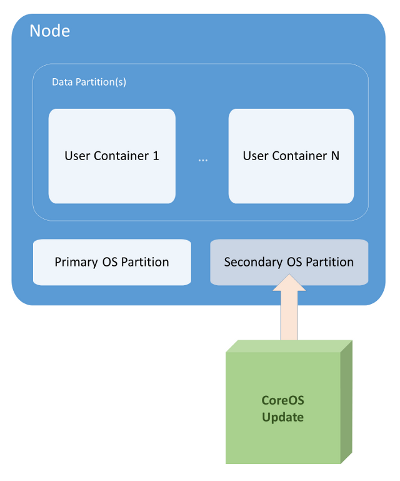While the specifications provide us with a common ground, there are also some trends evolving around the choice of OS for our containers. There are several tailored-fit OSes that are being developed specifically to run container workloads. Although implementations vary, they all have similar characteristics. The focus is on a slim installation base, atomic OS updating, and signed applications for efficient and secure operations.
One OS that is gaining popularity is CoreOS. CoreOS offers major benefits for both security and resource utilization. It provides resource utilization by completely removing package dependencies from the picture. Instead, CoreOS runs all applications and services in containers. By providing only a small set of services required to support running containers and bypassing the need for hypervisor usage, CoreOS lets us use a larger portion of the resource pool to run our containerized applications. This allows users to gain higher performance from their infrastructure and better container-to-node (server) usage ratios.
Recently, CoreOS was purchased by Red Hat, which means that the current version of container Linux will evolve against Red Hat's container OS offering, Project Atomic. These two products will eventually turn into Red Hat CoreOS. If you consider the upstream community approach that Fedora takes to Red Hat Enterprise Linux, it seems likely that there will be something similar for Red Hat CoreOS.
This also means that Red Hat will be integration Tectonic, which we'll explore later in the chapter, and the Quay, the enterprise container registry that CoreOS acquired. It's important to note that the rkt container standard will not be part of the acquisition, and will instead become a community supported project.
Here's a brief overview of the various container OSes. There are several other container-optimized OSes that have emerged recently:
- Red Hat Enterprise Linux Atomic Host focuses on security with SELinux enabled by default and atomic updates to the OS similar to what we saw with CoreOS. Refer to the following link: https://access.redhat.com/articles/rhel-atomic-getting-started.
- Ubuntu Snappy also capitalizes on the efficiency and security gains of separating the OS components from the frameworks and applications. Using application images and verification signatures, we get an efficient Ubuntu-based OS for our container workloads at http://www.ubuntu.com/cloud/tools/snappy.
- Ubuntu LXD runs a container hypervisor and provides a path for migrating Linux-based VMs to containers with ease: https://www.ubuntu.com/cloud/lxd.
- VMware Photon is another lightweight container OS that is optimized specifically for vSphere and the VMware platform. It runs Docker, rkt, and Garden and also has some images that you can run on the popular public cloud providers. Refer to the following link: https://vmware.github.io/photon/.
Using the isolated nature of containers, we increase reliability and decrease the complexity of updates for each application. Now, applications can be updated along with supporting libraries whenever a new container release is ready, as shown in the following diagram:

Finally, CoreOS has some added advantages in the realm of security. For starters, the OS can be updated as one whole unit, instead of via individual packages (refer to the preceding diagram). This avoids many issues that arise from partial updates. To achieve this, CoreOS uses two partitions: one as the active OS partition, and a secondary one to receive a full update. Once updates are completed successfully, a reboot promotes the secondary partition. If anything goes wrong, the original partition is available as a fallback.
The system owners can also control when those updates are applied. This gives us the flexibility to prioritize critical updates, while working with real-world scheduling for the more common updates. In addition, the entire update is signed and transmitted via SSL for added security across the entire process.
